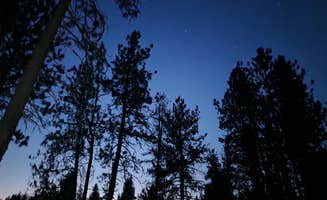Dispersed camping near Adams, Oregon provides access to Wallowa-Whitman National Forest's diverse wilderness environments. The Blue Mountains region contains elevations ranging from 3,000 to 5,000 feet across varied forested terrain. Summer temperatures typically reach 70-85°F during daytime hours while dropping to 40-50°F overnight, with forest roads often becoming impassable during winter months through late spring.
What to do
Wildlife viewing opportunities: North of Spring Creek on Forest Road 21 offers secluded forest areas where campers can observe local wildlife. "We had a little patch of forest all to ourselves... We heard gunshots from another site and saw shells at our site, so that's something to be aware of if wandering the forest," reports one visitor to North of Spring Creek on Forest Road 21.
Mushroom foraging: Seasonal morel mushrooms grow throughout the forest area, particularly in spring months. "Just past the village you get into the woodland where the Morels are plentiful. This is an ideal location to go mushrooming," notes Brandon K. who camped at McDougall Dispersed Camping.
Hiking local trails: The surrounding areas provide numerous hiking options. "Tons of great hiking around," shares Marasha L. about her experience at Wallowa-Whitman NF 21 - Dispersed. Hiking opportunities range from shorter 1-3 mile loops to more extensive trail systems connecting through the national forest.
What campers like
Privacy between sites: Many dispersed camping areas offer considerable separation between campsites. Ibeya A. notes that North of Spring Creek provides "dispersed, primitive camping sites spaced far apart from each other."
Wildlife sightings: Forest areas provide opportunities to see native wildlife in their natural habitat. "I saw lots of elk and turkeys(?) and a rattlesnake," reports mel B. about their stay at Wallowa-Whitman NF 21 - Dispersed.
Mountain views: Several areas offer scenic vistas across the Blue Mountains region. A visitor to Fox Hill Campground reports, "The views are incredible," noting the panoramic mountain scenery visible from higher elevation sites.
Variety of camping locations: The region provides numerous options for finding suitable sites. "There are 100s of spots to camp," notes Quincy B. about the dispersed camping along Forest Road 21, allowing visitors to select sites based on accessibility and privacy preferences.
What you should know
Weather preparedness: Winter conditions limit access to many sites. Hayley M. advises, "Stayed one night on my way to Seattle. I drove up the road some and found it pretty passable in my van, although most of the sites were too muddy and I was worried about getting stuck."
Road conditions: Many dispersed sites require navigating unpaved, potentially rough forest roads. "Great free place to camp 4x4 is advised and not really car accessible. Down side no water near by, not even a creek," warns a camper about North Elgin Dispersed Camp.
Noise considerations: Proximity to highways affects some camping areas. "Light sleepers would have a hard time here due to highway noise but overall good rest stop," notes Aspen S. about sites near Forest Road 21. Sites further from major roads provide quieter conditions.
Limited amenities: Most dispersed camping areas lack water sources or facilities. "Primitive location, nothing there, but maybe a fire ring and a spot to park your vehicle," reports Chris about the McDougall area, emphasizing the need to bring all necessary supplies.
Tips for camping with families
Insect preparation: Summer months bring increased insect activity in forested areas. Chris notes at McDougall: "Flying insects during the day. There are many so take appropriate action. Mostly flies and a couple different types of bees. By sunset, the insects went to sleep."
Site cleanliness concerns: Some dispersed areas have reported trash issues. "I was disappointed when I was checking out this area for camping... there was trash everywhere," reports Jodi about her experience looking for sites. Bringing trash bags and packing out all waste helps maintain area cleanliness.
Activity planning: Forest areas offer natural exploration opportunities for children. Brandon K. describes McDougall's surrounding area: "You'll see many types of wildlife here are hundreds of varieties of meadow wildflowers," providing educational nature observation opportunities for families.
Accessibility considerations: Select sites appropriate for your vehicle and equipment. "Well maintained roads. Sites are far apart but some lack privacy," notes mel B. about Wallowa-Whitman NF 21, suggesting families choose sites with adequate space for family camping setups.
Tips from RVers
Level parking areas: Finding suitable parking requires advance scouting. "Good level ground and easy to get back on the road in the morning," reports Aspen S. about Forest Road 21 sites, noting the importance of stable, level surfaces for overnight stays.
Road navigation challenges: Many forest roads present challenges for larger vehicles. Michael W. advises, "Would have driven further down into the woods if I had more time to set up as we got here late," suggesting arriving during daylight hours to navigate forest roads safely.
Site selection for larger vehicles: Roy S. shares about sites near Forest Road 21: "Camped atop the ridge, off the first road on the west side. Interstate traffic dominates the soundscape, but the scenery is expansive. There's several sites along the road, some with DIY fire pits. Given the off-road ruts, this isn't a prime wet ground camp area."


